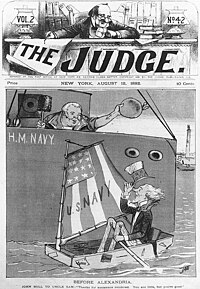Egyptian Expedition (1882)
| Egyptian Expedition | |||||||
|---|---|---|---|---|---|---|---|
| Part of the Second Anglo-Egyptian War | |||||||
 Front page of "Judge" magazine, 12 August 1882, featuring a cartoon by "JAW" concerning aid rendered by the American navy during the British bombardment of Alexandria. |
|||||||
|
|||||||
| Belligerents | |||||||
|
|
|
||||||
| Commanders and leaders | |||||||
|
|
|
||||||
| Strength | |||||||
|
Land: 73 marines 57 sailors Sea: 1 corvette 1 sloop-of-war 1 gunboat |
Unknown number of regular and civilian volunteer elements | ||||||
| Casualties and losses | |||||||
| None | Unknown | ||||||
United States victory;
The Egyptian Expedition, in mid-1882, was the United States' response to the British and French attack on Alexandria during the Anglo-Egyptian War. To protect American citizens and their property within the city, three United States Navy ships were sent to Egypt with orders to observe the conflict ashore and make a landing if necessary. British and French forces heavily damaged the city so a force of marines and sailors were landed and they assisted in fire fighting and guarding the American consulate from insurgents.
Rear Admiral James W. Nicholson, commander of the European Squadron, was directed to lead the expedition in the screw sloop USS Lancaster. Nicholson arrived at Alexandria on June 27, 1882, the gunboat USS Nipsic on July 1 and the corvette USS Quinnebaug on July 12. The British and French fleet, under Admiral Beauchamp Seymour, began anchoring off Alexandria on May 20 but they did not begin their bombardment until July 11. The Americans were informed by the British of their intentions so Rear Admiral Nicholson was able to warn the United States citizens within the city of a pending attack. When the engagement began, the British started shooting at the various forts under the command of Colonel Ahmed Orabi. The Egyptians defended the city well, striking the British ships several times though gradually the fortifications were reduced and silenced over the course of two days. During the bombardment, the Americans opened their ships up to all refugees from the city who needed shelter or medical treatment.
...
Wikipedia
